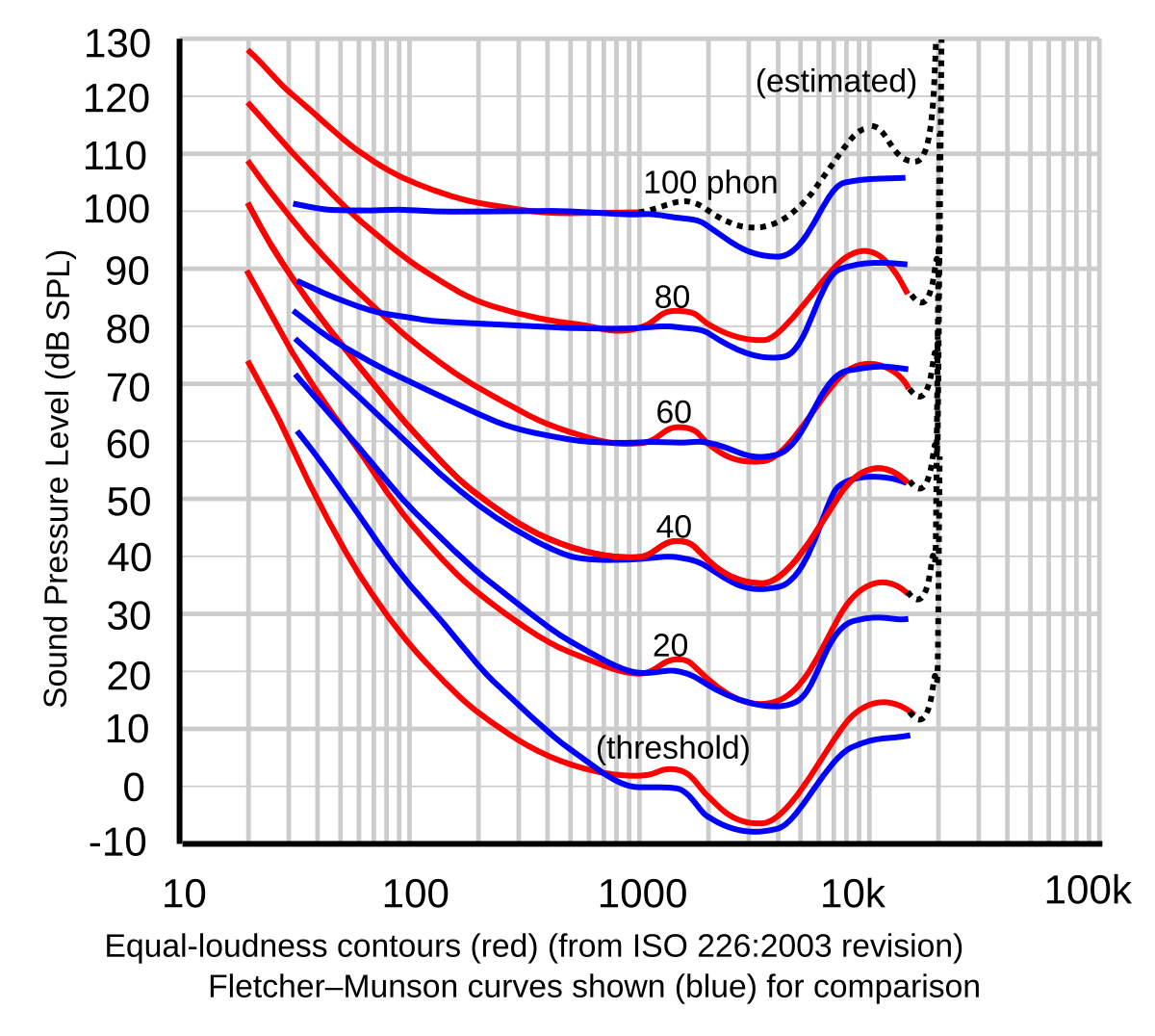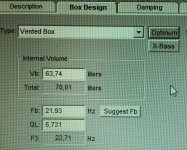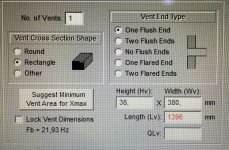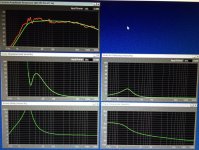Could be also an issue with the source used for testing...
That doesn't make any sense. He was sine wave testing. Even if the source had some kind of roll off built in, with single tones being tested, to driver excursion limits, it matters not.
Posted that elsewhere this morning but applies here too.And often forgotten is that there is a disconnect between physical sound measurements and human preferences. The concept of "house curve" (your personally preferred freq response OR the industry standard "preference" such as for movie theatres) captures my meaning as far as freq response goes. But there are other qualities such as ambiance, etc. where there are limitations to how far physical measurements can lead you.
For sure, physical measurements are essential and beneficial in a million ways. Just saying the development struggle doesn't end there.
I'll never understand why people are so sure that what a mic measures as flat sounds right to your ear. It sounds like weak bass. How can anybody mess with speakers for long in their home and not know this?
B.
Last edited:
True, but for EQing surely it wants to be flat? The recording mix takes care of how it's supposed to sound. If you EQ by ear, anything you subsequently play will sound bass heavyI'll never understand why people are so sure that what a mic measures as flat sounds right to your ear. It sounds like weak bass. How can anybody mess with speakers for long in their home and not know this?
The recording takes care of optimising it to sound best in what the mastering engineer determines to be the optimum/median/mean listening environment.scottjoplin said:The recording mix takes care of how it's supposed to sound
And a large amount of the potential environments which go towards weighting that mean, are indoors, in an untreated room with reasonably solid walls, with bass bouncing off the walls and ceiling and floor and back to your ears again. So if the mic measures flat then the bass is weaker than the mix was intended to be.
Actually a good mastering engineer probably shoots somewhere in the middle, and makes sure there are plenty of well pronounced harmonics in the bass notes, so it'll sound as good as possible outdoors as well as indoors, (our brain reinforces the bass so long as the harmonics are strong - psychoacoustically), but in any case most people grow up with their main experience of loud music playback from a young age, being in that indoor environment, or in even more exaggerated environments like concerts, cinemas, nightclubs etc, or in a car with the stereo playing, where the bass is usually just as exaggerated if not moreso.
So when it's not there it's generally missed (so much so that our brain literally fills it in for us if it should be there and isn't! But the mastering process may help to provoke that somewhat as well).
Edit: The other thing to note is that, due to the Fletcher-Munson 'equal loudness' curve, the quieter the music is, the louder the bass needs to be for us to perceive it to be the same volume.

So if you're playing at living room listening levels or even elevator muzak levels, that flat response is even more inadequate. By as much as 15-20dB, plus as much as 18dB to compensate for room response. So in a not completely impossible scenario, you might find a 35-40dB boost to the bass appropriate.
Last edited:
True, but for EQing surely it wants to be flat? The recording mix takes care of how it's supposed to sound. If you EQ by ear, anything you subsequently play will sound bass heavy
I believe you disagree with my point that perception of "flat" is not the same as measurement. Do the names Fletcher and Munson sound familiar to you?*
If you have recordings, male radio announcers, etc. made to sound right on quality speakers, the bass will sound generally weak if your system is flat.
Every couple of years, there's a thread about "how your system works" and people sheepishly admit they boost the bass as compared to the testimony of REW.
Any sheep out there that would like to speak up?
B.
*all those who know why this sort-of doesn't apply to treble deserve a certificate; and if you know why I say "sort-of" you get the advanced certificate
Last edited:
Oh, I do! Probably because I usually listen at a lower volume than it was mixed at, and I have the filthy luxury of tone controls 😱
You are wrong in your belief in your first sentence. I'm familiar with the equal loudness curveI believe you disagree with my point that perception of "flat" is not the same as measurement. Do the names Fletcher and Munson sound familiar to you?
I'm a Lamb. Does that count?bentoronto said:Any sheep out there that would like to speak up?
..
I mean, that's my name.
It is eye-opening to run tone-controls through REW. Any I've tested are unhelpful.,,,and I have the filthy luxury of tone controls
Having said that, I had a very fancy Kenwood pre-amp (C2) with what is called a 4-pot loudness control. IF you have the means for "gain management" in your audio chain, you could make that control make your room work like the Fletcher-Munson family of curves at different room loudnesses. No kidding.
Fellow owners of the DSP gear will know there is a long search for the precious Algorithm of Loundness.
B.
Last edited:
I've the tunable Doug Self tone controls which are better than the standard, and for bass I have them tuned low, for treble high to help compensate for HF hearing loss, quite happy with them.
Presumably it 'sort of' doesn't apply to treble because treble frequencies are directional, tiny, absorbed much more easily by walls, and much less likely to return directly to your ear at any point than bass frequencies which are omnidirectional, massive, still have lots of energy left in them after hitting a wall, and almost certainly return at least in part to your ear at some point. So in a cave or a space with specially designed acoustics and very solid walls, you can get the same effect with treble, but even then it's much more erratic and reverb-y (we're more likely to perceive reflected treble as many tiny and similar variations of a waveform instead of one coherent waveform)
There's probably also something I've missed about partial bass waveforms rejoining with other partial bass waveforms and coupling to form full and/or larger pressure waves, much more chance in general of a bass wave hitting another bass wave and coupling, and the crest of that coupled wave reaching our ear at some stage.
Something like this?
There's probably also something I've missed about partial bass waveforms rejoining with other partial bass waveforms and coupling to form full and/or larger pressure waves, much more chance in general of a bass wave hitting another bass wave and coupling, and the crest of that coupled wave reaching our ear at some stage.
Something like this?
Last edited:
Dayton Audio rss265hf 4-ohm
My box is
Net volume (gross minus driver, port, and bracing) 2.5 ft^3.
The port is 1.5"H x 14.5"W x 33.5"L for a tuning of 25Hz and max port velocity of 20 m/s at 22.5Hz.
WinISP shows a flat 110dB down to 25Hz and an F3 at 23Hz.
BassBox are mostly the same in calculations and predicted response.
Box should be ~60-65 Liters
Fb ~ 22 Hz

Port length in my calculation is a bit longer ~1400 mm.

Predicted response (in green) mostly the same to WinISD:

In red - response with some roomgain based on default settings.
Keep in mind low reference sensitivity, so for providing ~110 dB around 30-40 Hz this driver must work at its Xmax and Pmax.
As promised, here are some graphs with the sub basically in it's final intended placement. I'm pretty sure there are some huge room peaks going on as it's basically a square room with hard walls and no bass traps and the response is (as I suspected) nowhere near smooth. I've got a pretty stout xo slope currently set at 90Hz, but I'm sure I'll tweak it some more.
The red line is measured at approximately 1 meter away. The green line is with the mic stuffed about an inch or two in he port. Looks like final tuning is 21.8Hz instead of the intended 25Hz.
Here is the phase graph at about a meter away (same exact spot as the red line above). I really have no idea what I'm looking at with this one and would love to get a "nutshell" explanation of what's going on here to start getting my head around phasing a single driver.
The red line is measured at approximately 1 meter away. The green line is with the mic stuffed about an inch or two in he port. Looks like final tuning is 21.8Hz instead of the intended 25Hz.
An externally hosted image should be here but it was not working when we last tested it.
Here is the phase graph at about a meter away (same exact spot as the red line above). I really have no idea what I'm looking at with this one and would love to get a "nutshell" explanation of what's going on here to start getting my head around phasing a single driver.
An externally hosted image should be here but it was not working when we last tested it.
CRIKEY!!! It's AWFUL at listening position with REW. There are some room modes for sure! That and the sub is behind stuff and doesn't have a straight shot to my ears. It's probably just a matter of getting it as close as I can in this room. Unless.....nobody said I couldn't put it behind my desk instead of in front of my desk... Though it might sound kinda weird with the bass coming from behind me. Well, shoot, I might just have to build another box and set one on each side of me. I can't set this one in a corner. I can't stand the sound of lop-sided bass. Plus, I'd want to go deaf in both ears at the same rate, so that's always a consideration. 😀
Last edited:
I came back to this thread after having been asked, dismissd it the 1st time. mostly because you used MDF to build the box — MDF is not a great speaker building material and makes no sense for a woofer.
My sims basically mirror yours, a 1 dB hump at just over 30 Hz, and same vent size. Not a tuning i’d use or recommend even with the high aspect vent working to tame the bump — you have to factor in room gain. My sim shows the woofer running out of xmax at 500w.
As has been said, it is only a single 10”, i choose to use 4 10” in my system (but i mostly didn’t use them).
It seems you have tracked your issues down to room modes, they can be a bitch.
dave
My sims basically mirror yours, a 1 dB hump at just over 30 Hz, and same vent size. Not a tuning i’d use or recommend even with the high aspect vent working to tame the bump — you have to factor in room gain. My sim shows the woofer running out of xmax at 500w.
As has been said, it is only a single 10”, i choose to use 4 10” in my system (but i mostly didn’t use them).
It seems you have tracked your issues down to room modes, they can be a bitch.
dave
If you're going to be listening mostly in one place, you can use EQ to knock down the worst of the peaks.
A room I did quite a few measurements in had a 10dB peak at 40Hz at pretty much all seats. It was great for small speakers that roll off at 50Hz, because they just about excite the room at 40Hz, and get a 10dB boost for it. They sounded much bigger than they are. Get something that'll go to 20Hz, though, and it sounded lumpy and awful.
Since the peak was showing up in 5/6 seats, I knocked it down. Much much better.
Chris
A room I did quite a few measurements in had a 10dB peak at 40Hz at pretty much all seats. It was great for small speakers that roll off at 50Hz, because they just about excite the room at 40Hz, and get a 10dB boost for it. They sounded much bigger than they are. Get something that'll go to 20Hz, though, and it sounded lumpy and awful.
Since the peak was showing up in 5/6 seats, I knocked it down. Much much better.
Chris
Here's my take. Sealed and bass reflex designs are easy to design and able to please most because the parameters and science behind the designs are well established. But I'm not most, and it appears you aren't either.
Your design looks a bit like a transmission line. Here is where it gets tricky.
From what you've stated it seems like you're underwhelmed. This is most likely due to the transmission line section being too long. It is stifling the sound and behaves closer to a sealed box. However, the loading chamber looks quite large relative to the narrowed section. Your sub will sound both limp and muted.
I personally like tight accurate bass but would use the transmission line to allow the sub to breathe a bit. Too much back pressure stifles the ability of the sub. This is a problem of completely sealed designs.
Here is what I think you would like. A smaller loading chamber and a shorter transmission line. You'll have more punch and accurate bass but the reflex bass will come out more quickly adding to the overall impact. Accuracy will be limited due to time delays (this is so marginal it doesn't really matter to most), but most don't care and simply love this sound. At times I think I kid myself that I care about accuracy as much as I do.
And here is what I think I would like. Smaller loading chamber (just like your recommendation) but the same transmission line or even longer for me. I tend to go for accuracy (even if it is marginal) and the longer transmission line would tamp down the sound escaping from the port which I really don't want.
My recommendation for you: Cut the top board that starts the transmission line at the half way point. Use another board on the back of the loading chamber to shrink the loading chamber size. It'll add weight and you'll have a dead space, but no big deal.
Transmission lines plus that snail shape nautilus bowers and wilkins design seems to be the best.
IMHO, most transmission lines have way too much volume. They appear little different than an infinite baffle.
Your design looks a bit like a transmission line. Here is where it gets tricky.
From what you've stated it seems like you're underwhelmed. This is most likely due to the transmission line section being too long. It is stifling the sound and behaves closer to a sealed box. However, the loading chamber looks quite large relative to the narrowed section. Your sub will sound both limp and muted.
I personally like tight accurate bass but would use the transmission line to allow the sub to breathe a bit. Too much back pressure stifles the ability of the sub. This is a problem of completely sealed designs.
Here is what I think you would like. A smaller loading chamber and a shorter transmission line. You'll have more punch and accurate bass but the reflex bass will come out more quickly adding to the overall impact. Accuracy will be limited due to time delays (this is so marginal it doesn't really matter to most), but most don't care and simply love this sound. At times I think I kid myself that I care about accuracy as much as I do.
And here is what I think I would like. Smaller loading chamber (just like your recommendation) but the same transmission line or even longer for me. I tend to go for accuracy (even if it is marginal) and the longer transmission line would tamp down the sound escaping from the port which I really don't want.
My recommendation for you: Cut the top board that starts the transmission line at the half way point. Use another board on the back of the loading chamber to shrink the loading chamber size. It'll add weight and you'll have a dead space, but no big deal.
Transmission lines plus that snail shape nautilus bowers and wilkins design seems to be the best.
IMHO, most transmission lines have way too much volume. They appear little different than an infinite baffle.
- Status
- Not open for further replies.
- Home
- Loudspeakers
- Subwoofers
- I made a sub. It sucks. Why?
